What does it mean to have the right-of-way?
Whenever someone says “right-of-way” they are usually talking about some type of understanding that drivers have with regard to which road user is going to go first before another in a driving situation. In other words, who must yield to who whenever two or more road users would like to enter the same space at the same time.
Someone needs to go first. Otherwise, two or more road users entering the same space at the same time is equal to a collision. For a related article, check out Right-of-way in the parking lot.
No one really “has” the right-of-way – an attitude shift
Nobody really “has the right-of-way.” The driving school where I learned how to become a driving instructor would have absolutely, positively fired me if I ever started teaching drivers that they simply “had the right of way.”
This is not just some geeky language technicality, but an important attitude shift, purposefully in place to prevent crashes.
Rather than thinking someone “has the right of way,” it’s more accurate – when you think about it – that certain road users should yield to others; they’re merely supposed to. It doesn’t mean they’re actually going to yield. Driving is dangerous, and we utilize this kind of attitude to greatly reduce risk.
Admittedly, someone has to give the right-of-way, and someone else has to take it. Otherwise, no one would get where they were going, and on every corner would be a Mexican standoff, forever. The trick to safe driving is to know when to give, but also when to take the right-of-way with confidence.
Right-of-way is “that space at that time”
Technically speaking, right-of-way is literally equal to “that space at that time.” If one driver yields to another, then the other has been given the right to safely use that particular space on the road at that particular moment in time.
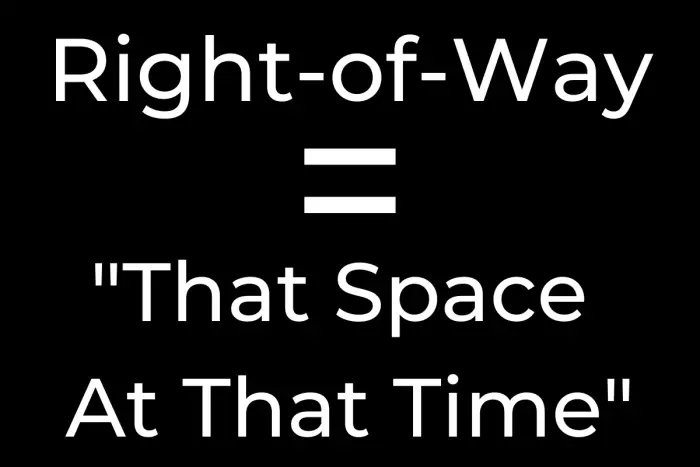
Yield to whoever was there first
One good thing to realize about driving right-of-way is that no matter what kind of traffic control device there is – or isn’t – at any particular location, and no matter what is “supposed to happen,” drivers must legally yield to any other road user that has entered any space before they did. If he/she/it/they got there before you, yield.
Right of Way in the Motor Vehicle Act
The British Columbia Motor Vehicle Act, contains many references to the phrase “right-of-way,” but the majority of them are related to intersections that are controlled by traffic lights. They basically specify who goes first in various situations. Generally speaking, pedestrians are given priority over all other vehicles. This is true as long as the pedestrian is following the pedestrian rules properly.
Right-of-way at 2-way stop intersections
When you’re driving on a through street, coming up to a typical two way stop sign, neither you or the driver facing you has a stop sign. Both vehicles must yield to pedestrians and cyclists first and foremost.
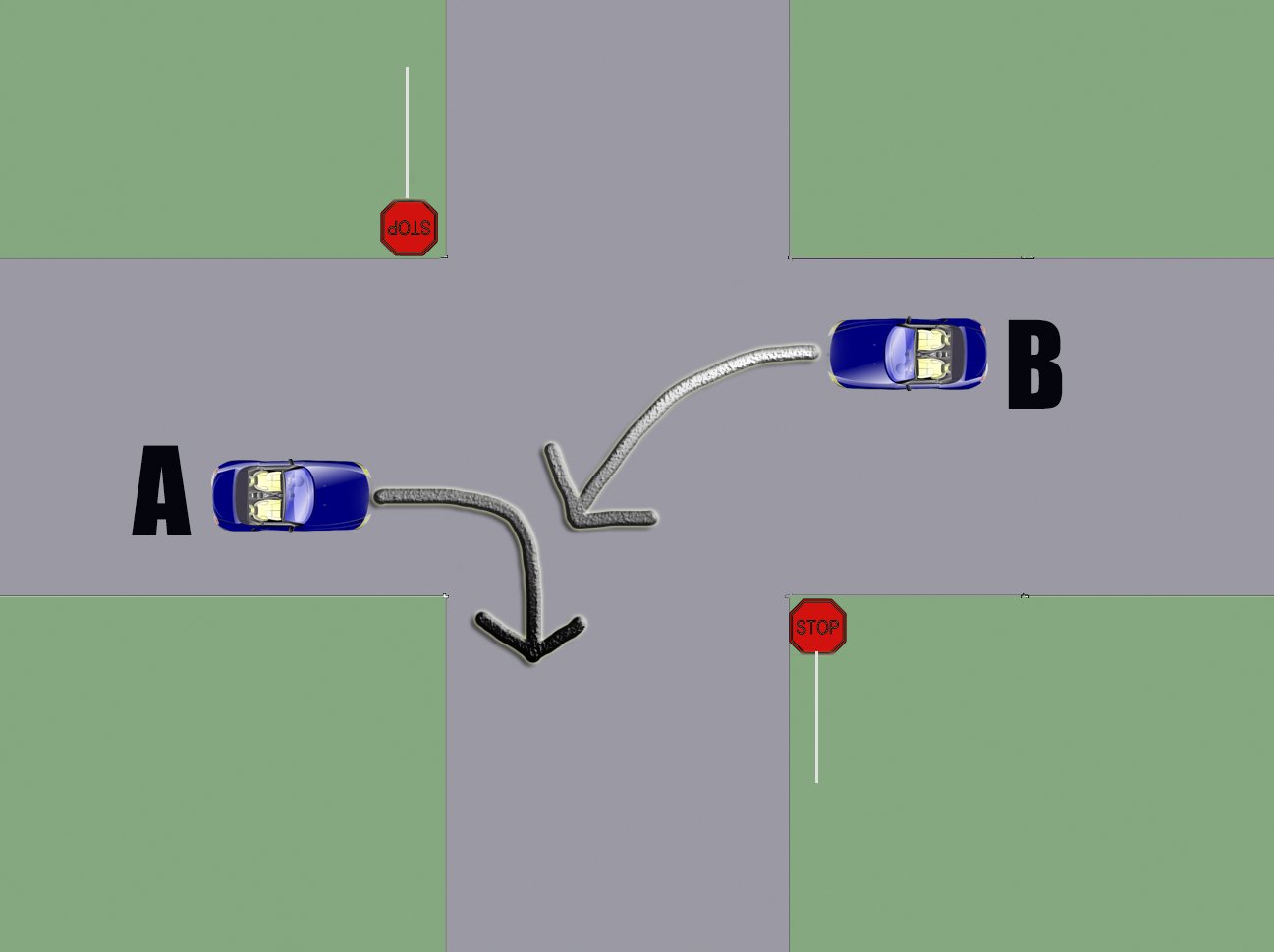
2 Way Stop Rules
Who has the right of way at a 2 way stop in Canada?
- Drivers facing a 2-way stop sign must stop their vehicle completely and first yield to any pedestrians and traffic on the through street, and may only proceed when safe
- If two vehicles arrive at the same time, drivers must yield the right-of-way to whichever vehicle completely stopped and then entered the intersection first
- If two vehicles stop at the same time, drivers turning left should yield to drivers planning to continue straight through
Right-of-way: Traffic light turns
For the typical traffic light, let’s say it’s a green traffic light.
- Right-turning and left-turning drivers must yield to pedestrians
- Left-turning drivers must yield to right-turning drivers

4-Way Stops Right-of-way
- Whoever stopped first, should go first (if safe)
- If you stopped second, go second
- If you stop at the same time, yield to the right
- If you stop at the same time, the left turn yields to the right turn, and the left turn yields to straight through
- Check out my full guide to 4-way stops
Vehicles exiting lane/driveway/parking lot
Any vehicle exiting a lane, driveway, or parking lot are legally required to stop completely and yield to pedestrians and all other road users before proceeding, just the same as a stop sign. To learn more, check out our blog Emerging from a Lane, Driveway, or Parking Lot.
What is a through street?
According to the Act, “through highway” means a highway or part of a highway at the entrances to which stop signs are erected under this Act;
Generally, when people say through street it means a street along which the traffic “has the right-of-way” over vehicles entering or crossing at intersections.
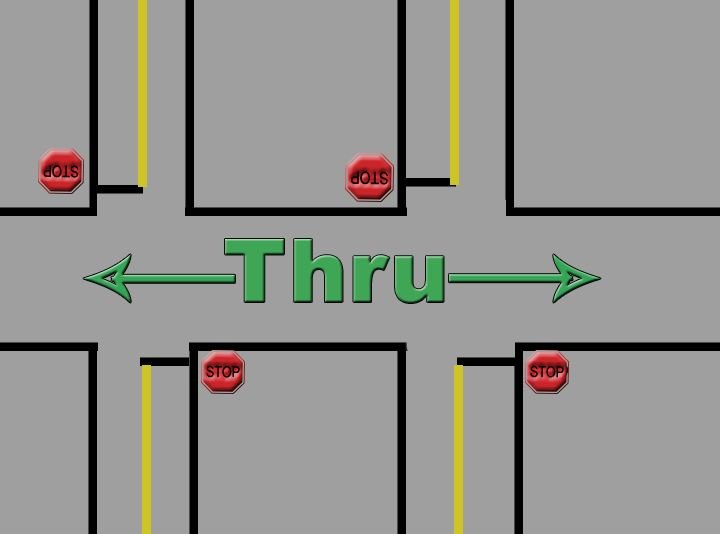
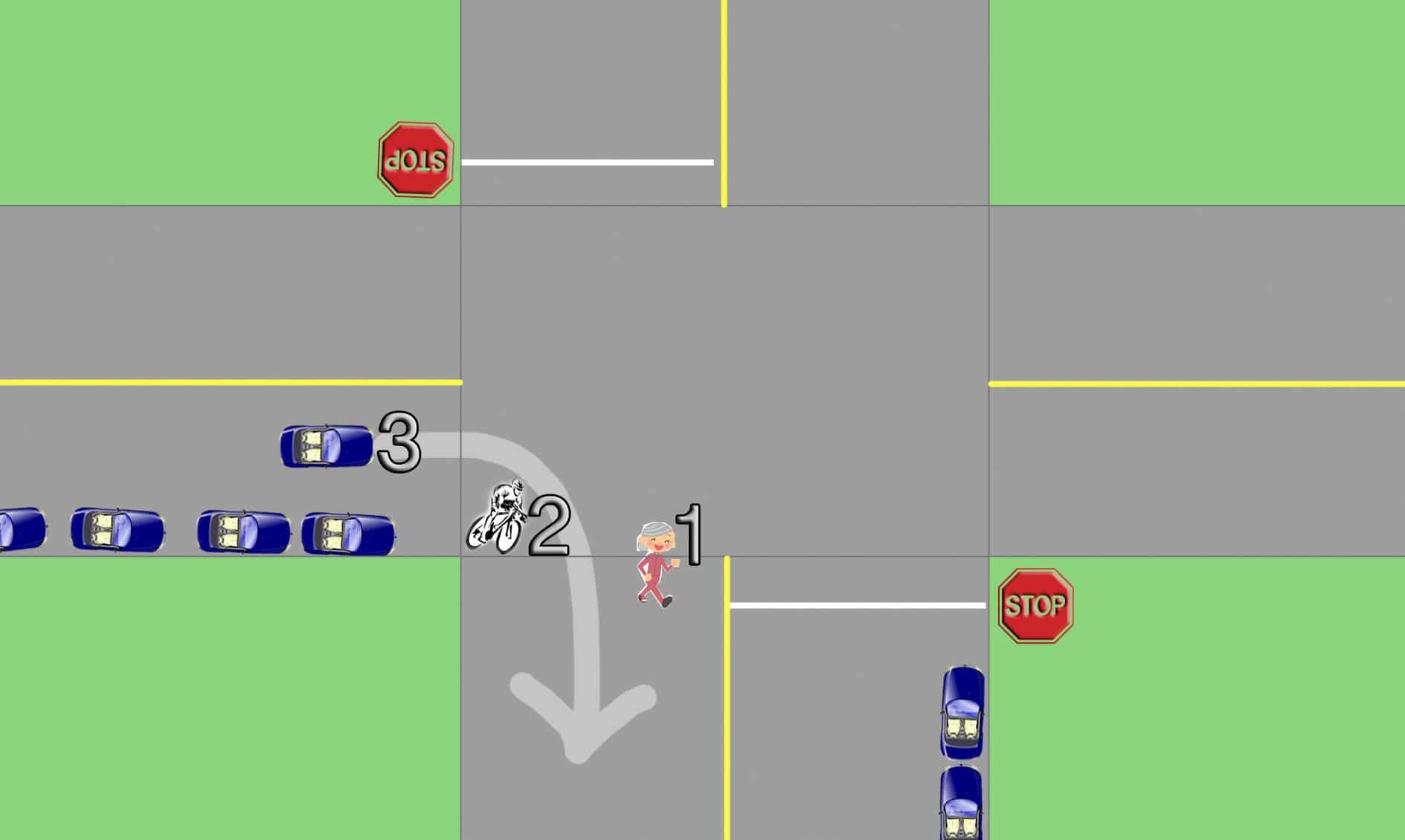
Why do we yield to the right and not the left?
If we yield to the right, it clears the intersection faster than if we yield to the left.
In many circumstances, you do not need to wait until the other car is gone into the far distance, disappearing over the horizon, and the dust settling on the ground before you start to roll; you should start rolling when the other vehicle is pretty much out of your way.
This is all based on the idea that the point of driving is to get somewhere, and clearing intersections in the most efficient manner possible would benefit everyone.
If Car A goes first (the car on the “Right”), then Car B can start rolling when Car A is about halfway through the intersection:
If Car B went first (the car on the “Left”), then Car A would have to wait until Car B got across the entire intersection, remaining fully stopped, and then could proceed. This would take longer (especially when the roads are very wide).
Carmen Cohoe
Carmen became a driving instructor in beautiful North Vancouver at the age of 22 due to some crazy people who agreed to hire her. After that, there was never a dull moment teaching many different folks from many different places how to drive using automatic and standard vehicles and a minivan.



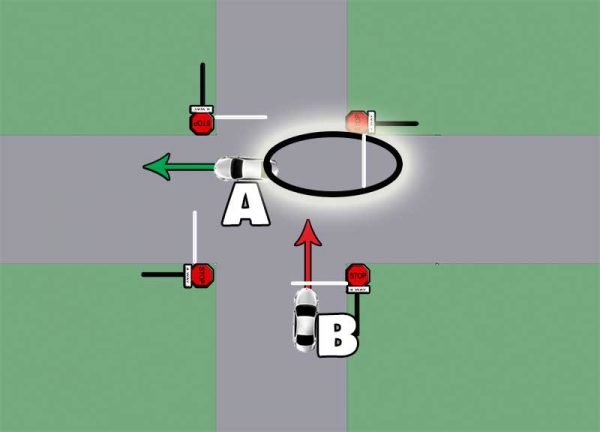
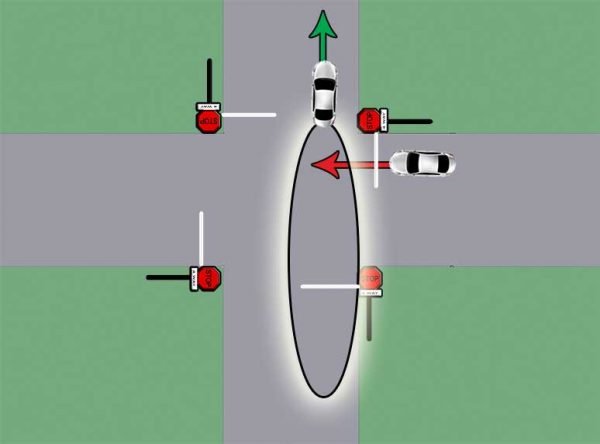

What do you think of this? It’s a little confusing. Car A is making a left turn into a parking lot across 2 lanes of traffic plus a right turn lane for an intersection 100 yards behind Car A. The light is red and traffic has backed up in the 2 opposite direction lanes. Nice people in both lanes make room and wave Car A through. However, Car B is racing up to the intersection and pulls into the right turn lane at the same time Car A starts the left turn. They collide. Who is at fault?
I don’t know, I usually try to avoid collisions so I never have to figure out who’s fault it is. But in my opinion it is both their faults, Since it does take 2 drivers to have a collision in which 2 cars are involved. Just my opinion.
I would say Car A. Car B was in a through lane in the opposite direction of travel and in order for Car A to travel across the opposite lanes of travel if safe to do so. Just because someone waves you through does not mean its safe. It means the person waiving you through thinks its safe and can’t see the car that has the right of way.
Hi, teaching my daughter to drive and we have a minor disagreement. Car A is traveling south and arrives at a stop sign at an intersection at the same time as northbound Car B arrives at its stop sign opposite. They both wish to turn left, Car A to continue east, Car B to continue west. There is no other traffic around and both can proceed. Who has the right of way or can they both make their opposite left turns at the same time?
Hi, Read this : http://www.drivesmartbc.ca/rules-road/drivers/right-way-two-way-stop
Legalities aside, it is unwise to assume that just because a car has a left turn signal, that it will actually turn left; so going at the same time might be possible but I would recommend extreme caution and I would want some more evidence that the vehicle is actually going to turn, such as you can see the front tires turning that direction.
thanks! We both agreed that if she was unsure she should not go, but she was confused I think about the other car being in her lane to make the turn. We will talk more about it on the next lesson.
Ohhh yes I see. Typically there’s room to go at the same time, it’s just a matter of making sure it is actually safe and the other car is actually turning. Hope it all goes well. Teaching driving isn’t exactly easy so let me know how you guys are doing, Remember to drive to the ice cream place once in a while. :)
https://uploads.disquscdn.com/images/b574f5b0b9c36a964a742edb1dfe732d7e85985d158413c8567a70d40d5a9806.jpg
Thank you! The graphic will help a lot as will the ice cream :)
I have a similar question, which I should probably know the answer to by now since I’ve had my license for 5+ years. It just never really occurs to me until it’s happening.
Let’s say we have the same exact scenario, Car A going south turning east, car B turning west. However, we’re at a red light turning green. Cars behind the turning cars start going around A and B, straight through the intersection because both A and B are trying to yield to each other. Visibility for A is blocked by B and vice versa. You can either take a chance that the through traffic is done, and maybe get t-boned, or you can continue yielding and waiting for the opposite car to do the same. What’s the best way to handle this situation?
Often times I am unsure whether the cars going straight behind the opposite turning car are going to “wait their turn” (meaning both A and B would HAVE to turn at the same time), or only wait until a/b has yielded to long for their liking, whipping around them and resulting in an accident. The rightmost vehicle going first doesn’t work because the vehicles are opposite each other.
I sometimes run into the issue of starting my left turn, only to see a car making a right turn into the same lane that was hidden behind the car turning left, or rapidly approaching and assuming right of way.
Hi. The answer is simple and that is if you don’t have 100% visibility/certainty then just wait. The longest you’ll wait is for the yellow/red light when you’ll be exiting the intersection when safe anyway, so no need to feel rushed.
what is the formal/legal stand on the right of way at an intersection when the light turns yellow for these two cases?
1) car going straight at amber where it could stop VS car waiting at intersection to turn left?
2) car turning right into a one way road at amber VS the car waiting at intersection to turn left?
Hi. I wrote something very similar about this subject : http://drivinginstructorblog.com/q-right-of-way-at-amber-traffic-light-intersection/
accident
turn left is uncontrolled traffic., car A turning left into mall., mall entrance have 3 line, one is for exit
car B turning right into 1st line of mall entrance but the van in front of car B is over the height limit of the mall.,
car A turn left behind car B insted taking 2nd line of mall entrance.,
car B check left shoulder saw island and right should and rear window for backing into the corner right side of the street.
car B front bumper driver side hit the front bumper passenger side of car A., no horn apply
car B did not expect car A.,
because there is 2nd line for turning left (some call fast line)
whos is fault.,?
cambie left turn is uncontroled traffic in oakridge mall entrance.,!
https://www.google.ca/maps/@49.2322101,-123.1164332,3a,90y,264.36h,50.82t/data=!3m4!1e1!3m2!1sdKHHpJheg6mUvtovAChUSw!2e0
here is other view., turning left is no totaly any sign, stop line or yield., all u see if you turning left from there is arrow straight in mall entrance
https://www.google.ca/maps/@49.232367,-123.1164279,3a,75y,193.34h,56.6t/data=!3m4!1e1!3m2!1sKI4ecaNBubooRa_vgEk_hQ!2e0
Hi, Sorry to hear. I am honestly not too sure, Sorry! :( ICBC is much better at determining fault. I don’t have a lot of experience with it actually. I think that a Left turn would be required to yield to right turns in this case, although if the left turn went into the left lane and the right turn went into the right lane then there wouldn’t be a problem right? (this left lane is not a ‘fast lane’ into a mall parking lot, we do have the left lane designated as a fast lane on the HIGHWAY/FREEWAY ONLY!) Anyway, it might be partially the fault of both of the vehicles. I am not quite sure exactly where the cars were. It is sort of hard to tell from your description. Please let me know what you find out.
I am turning left on a left-turn green arrow with a green light on to a two lane street and want to immediately be in the right lane because I want to turn right at the next block. I have my right turn indicator on. A vehicle from the opposite direction is turning right on a red light with a ‘yield to right of way’ triangle sign. There is not a merge lane for the right turning vehicle. Is the right turning vehicle supposed to wait for the green light? And if not, who has the right of way for the right lane?
Which intersection is this? Is he facing a red light, or a yield sign? (Usually it is one or the other) In any case, that car (turning right) is required to yield to any traffic and not go to until safe. The motor vehicle act never says that the left lane belongs to the left turning car, and the right lane belongs to the right turning car. It says cars facing red lights and yield signs are required to yield to any traffic on the road and not to go until it is safe.
While you do not want to turn directly into the right lane (you’re supposed to initially turn into the left lane), if you start your left turn and then switch to the right turn signal and plan a lane change immediately after the intersection, this is a legal lane change. However, can you trust the other car? No probably not right? Some drivers seem to think that the left turning car HAS TO stay in the left lane, allowing them to turn right at the exact same time. This is dangerous in general not to stagger a turn and to expect to be able to turn right ON A RED LIGHT (red means stop, and yield, yes?) at the same time as a vehicle lawfully going through the intersection on a GREEN arrow! Obviously to be defensive and avoid crashing into them, though, you may have to put up with them and be careful – honk and tell them to stay put if you think that will work – and if they turn, may have to slow down in order to get to the right lane to be able to do your right turn…in other words use caution. I am not sure if you would be found partially at fault in the case of a collision because technically you would have done an “unsafe lane change” … and they would have done an unsafe turn against a red signal / yield.
Right Turn
(3) Despite subsection (1), and except when a right turn permitted by this subsection is prohibited by a sign at an intersection, the driver of a vehicle facing the red light, and which in obedience to it is stopped as closely as practicable to a marked crosswalk on the near side of the intersection, or if there is no marked crosswalk, as closely as practicable to the intersection, may cause the vehicle to make a right turn, but the driver must yield the right of way to all pedestrians and vehicles lawfully proceeding as directed by the signal at the intersection.
Left Turn
(3) When the driver of a vehicle intends to turn the vehicle left at an intersection where traffic is restricted to one direction on one or more of the highways, the driver must cause the vehicle to approach the intersection in the extreme left hand lane available to traffic moving in the direction of travel of the vehicle, and after entering the intersection turn the vehicle to the left so as to leave the intersection as nearly as practicable in the left hand lane available to traffic moving in the direction of travel of the vehicle on the highway being entered.
Yield signs
(2) Except as provided in section 175, if 2 vehicles approach or enter an intersection from different highways at approximately the same time and there is a yield sign, the driver of a vehicle facing the sign must yield the right of way to all other traffic.